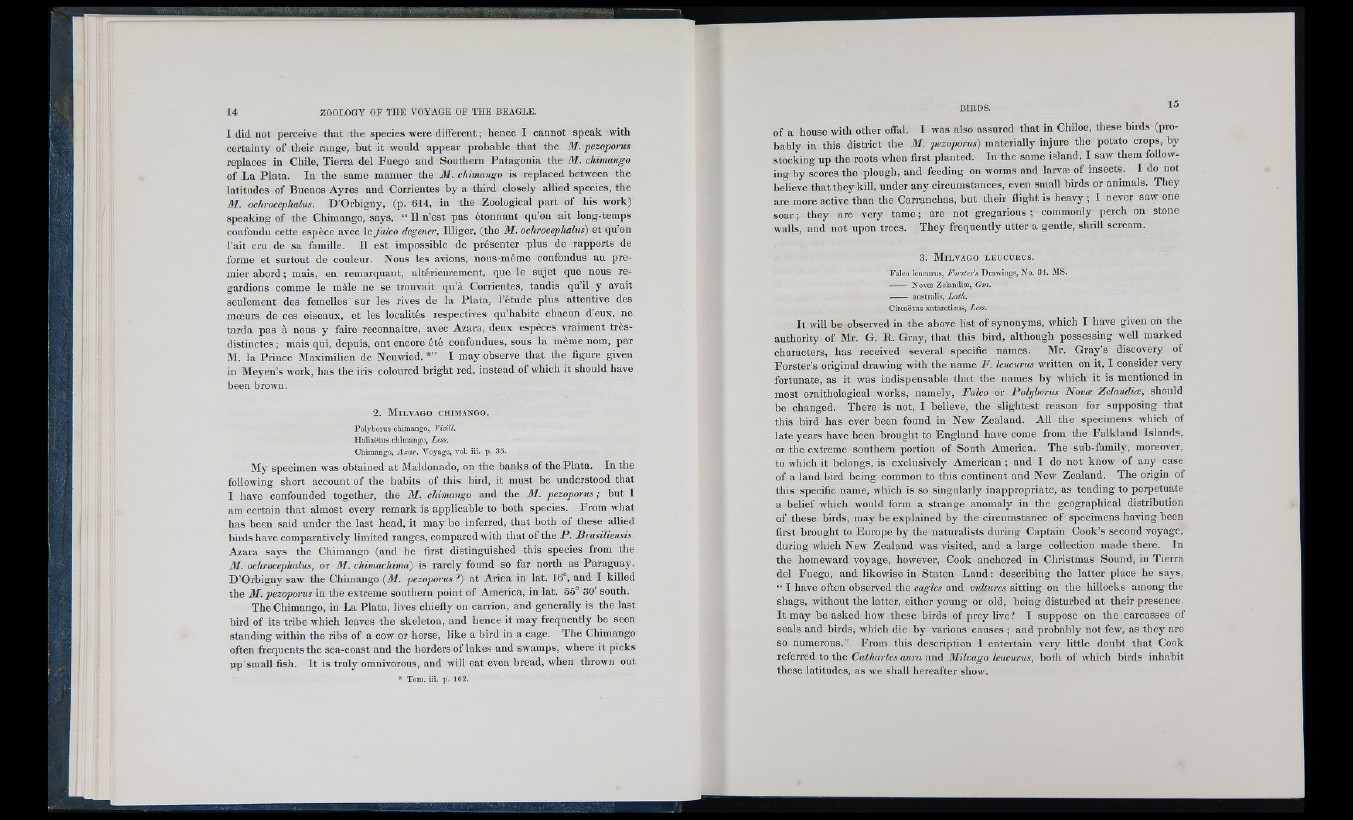
• w wai»' n w » '
14 ZOOLOGY OF THE VOYAGE OF THE BEAGLE.
I did not perceive that the species were different ; hence I cannot speak with
certainty of their range, but it would appear probable that the M. pezoporus
replaces in Chile, Tierra del Fuego and Southern Patagonia the M. chimango
of La Plata. In the same manner the M. chimango is replaced between the
latitudes of Buenos Ayres and Corrientes by a third closely allied species, the
M. ochrocephalus. D ’Orbigny, (p. 614, in the Zoological part of his work)
speaking of the Chimango, says, “ l l n ’est pas étonnant qu’on ait long-temps
confondu cette espèce avec le falco degener, Illiger, (the M. ochrocephalus) et qu’on
l ’ait cru de sa famille. Il est impossible de présenter plus de rapports de
forme et surtout de couleur. Nous les avions, nous-même confondus au premier
abord; mais, en remarquant, ultérieurement, que le sujet que nous regardions
comme le mâle ne se trouvait qu’à Corrientes, tandis qu’il y avait
seulement des femelles sur les rives de la Plata, l’étude plus attentive des
moeurs de ces oiseaux, et les localités respectives qu’habite chacun d’eux, ne
tarda pas à nous y faire reconnaître, avec Azara, deux espèces vraiment tres-
distinctes ; mais qui, depuis, ont encore été confondues, sous la même nom, par
M. la Prince Maximilien de Neuwied. *” I may observe that the figure given
in Meyen’s work, has the iris coloured bright red, instead of which it should have
been brown.
2 . M i l v .a g o c h im a n g o .
Polyborus chimango, Vieill.
Haliaëtus chimango. Less.
Chim.ango, Aza r. Voyage, vol. iii. p. 35.
My specimen was obtained at Maldonado, on the banks of the Plata. In the
following short account of the habits of this bird, it must be understood that
I have confounded together, the M. chimango and the M. pezoporus; but I
am certain that almost every remark is applicable to both species. From what
has been said under the last head, it may be inferred, that both of these allied
birds have comparatively limited ranges, compared with that of the P. Brasiliensis.
Azara says the Chimango (and he first distinguished this species from the
]\I. ochrocephalus, or M. chimachima) is rarely found so far north as Paraguay.
D ’Orbigny saw the Chimango {M. pezoporus ?) at Arica in lat. 16°, and I killed
the M. pezoporus in the extreme southern point of America, in lat. 55° 30' south.
The Chimango, in La Plata, lives chiefly on carrion, and generally is the last
bird of its tribe which leaves the skeleton, and hence it may frequently be seen
standing within the ribs of a cow or horse, like a bird in a cage. The Chimango
often frequents the sea-coast and the borders of lakes and swamps, where it picks
up small fish. It is truly omnivorous, and will eat even bread, when thrown out
* Tom. iii. p. 162.
of a house with other offal. I was also assured that in Chiloe, these birds (probably
in this district the M. pezoporus) materially injure the potato crops, by
stocking up the roots when first planted. In the same island, I saw them following
by scores the plough, and feeding on worms and larvee of insects. 1 do not
believe that they kill, under any circumstances, even small birds or animals. They
are more active than the Carranchas, but their flight is heavy ; 1 never saw one
soar; they are very tame; are not gregarious ; commonly perch on stone
walls, and not upon trees. They frequently utter a gentle, shrill scream.
3 . M i l v a g o l e u c u r u s .
Falco leucurus, Forster's Drawings, No. 34. MS.
Novæ Zelandiæ, Gm.
australis. Lath.
Circaëtus antarcticus. Less.
It will be observed in the above list of synonyms, which I have given on the
authority of Mr. G. R. Gray, that this bird, although possessing well marked
characters, has received several specific names. Mr. Gray’s discovery of
Forster’s original drawing with the name F. leucurus written on it, I consider very
fortunate, as it was indispensable that the names by which it is mentioned in
most ornithological works, namely, Falco or Polyborus Novæ Zelandiæ, should
be changed. There is not, I believe, the slightest reason for supposing that
this bird has ever been found in New Zealand. All the specimens which of
late years have been brought to England have come from the Falkland Islands,
or the extreme southern portion of South America. The sub-family, moreover,
to which it belongs, is exclusively American ; and I do not know of any case
of a land bird being common to this continent and New Zealand. The origin of
this specific name, which is so singularly inappropriate, as tending to perpetuate
a belief which would form a strange anomaly in the geographical distribution
of these birds, may be explained by the circumstance of specimens having been
first brought to Europe by the naturalists during Captain Cook’s second voyage,
during which New Zealand was visited, and a large collection made there. In
the homeward voyage, however, Cook anchored in Christmas Sound, in Tierra
del Fuego, and likewise in Staten Land : describing the latter place he says,
“ I have often observed the eagles and vultures sitting on the hillocks among the
shags, without the latter, either young or old, being disturbed at their presence.
It may be asked how these birds of prey live? I suppose on the carcasses of
seals and birds, which die by various causes ; and probably not few, as they are
so numerous.” From this description I entertain very little doubt that Cook
referred to the Cathartes aura and Milvago leucurus, both of which birds inhabit
these latitudes, as we shall hereafter show.